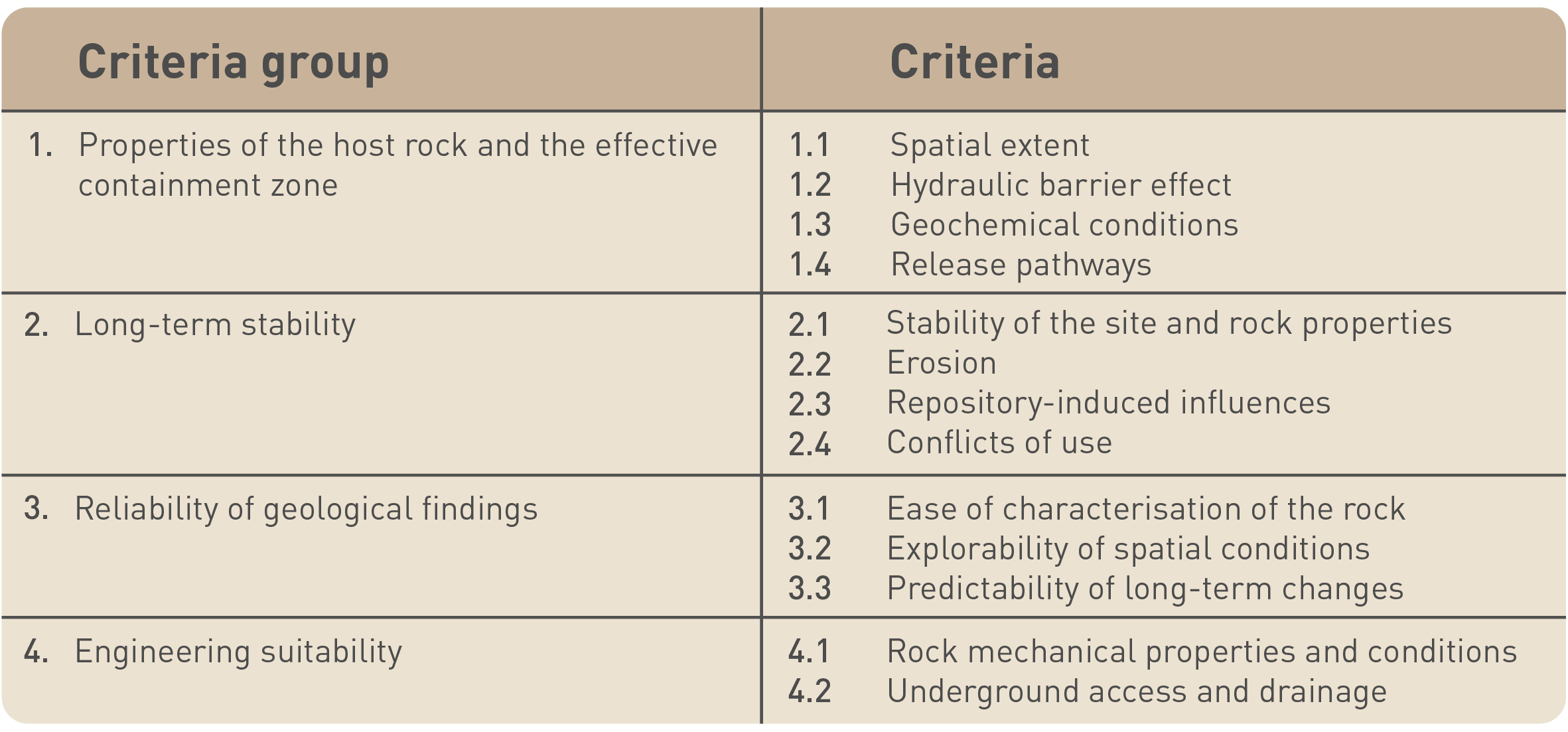In Switzerland, a formal site selection process was put in place by the federal government to identify the most suitable geological situation for the deep geological repository (SFOE 2008). The Sectoral Plan for Deep Geological Repositories (SGT) defines 13 site selection criteria addressing long-term safety and engineering suitability (Fig. 1‑2), grouped as follows:
-
Group 1 criteria mainly consider the geometry and safety-relevant properties of the CRZ including the geochemical conditions in the host rock relevant for the stability of the engineered barriers. The assessment of the hydrogeological situation at the sites considers independent evidence for slow transport (e.g. porewater composition, hydraulic heads, groundwater residence times in neighbouring aquifers).
-
Group 2 is concerned with the evolution of the CRZ during the period under consideration (up to 100'000 years for L/ILW and up to one million years for HLW), specifically to consider the effects of geodynamic, climatic and erosional long-term processes, repository-induced effects and human actions.
-
Group 3 addresses uncertainties originating from limitations on the level to which it is possible to characterise the geological barrier and extrapolate understanding as well as to predict its long-term evolution.
-
Group 4 criteria assess the constructability of the repository in the host rock and the access infrastructure through the overlying strata at each site.
The SGT (SFOE 2008) requires site selection in Switzerland to be staged, based on a safety-based site comparison. The first of the three stages comprised a nationwide screening process for suitable host rocks and siting regions, resulting in the identification of six siting regions and three potential host rocks. Further investigations in Stage 2 selected the Opalinus Clay as the only host rock to be further investigated. This stage also selected three of the six siting regions to be taken forward for detailed investigations in Stage 3, the final stage. These three siting regions, JO, NL and ZNO, are located in Northern Switzerland. Section 1.5 presents the main arguments favouring these regions.

Fig. 1‑2:Criteria to be used for site selection (SFOE 2008)
The site comparison process in SGT Stage 3 includes the following key steps (see Nagra 2025a for a full description with links to the regulatory guidelines):
-
Definition of the potential disposal zone and delineation of the CRZ with spatial reserves:
All three siting regions have potential disposal zones in the Opalinus Clay with large lateral extents that far exceed the spatial requirements according to the current repository design. Key factors determining the lateral extent of the potential disposal zone are (1) the avoidance of regional tectonic elements and larger tectonic faults and (2) the choice of an overall suitable minimum depth of the host rock with respect to future erosion.
For the site comparison, CRZs were defined with lateral dimensions considerably smaller compared to the potential disposal zone. These fulfil a standardised lateral spatial requirement (2 km2 and 1.2 km2 for HLW and L/ILW, respectively). CRZs with spatial reserves include a multiple of this (6 km2 and 3.6 km2 for HLW and L/ILW, respectively). Vertically, the CRZ includes the host rock and the surrounding low-permeability confining units. The delineation of the CRZ and spatial reserves requires a detailed geological and hydrogeological characterisation of the geological units above and below the host rock and a well-known host rock geometry and local fault pattern in the area of the potential disposal zone.
-
Definition of provisional site-specific repository designs as the basis for quantitative safety analyses and qualitative evaluation:
The delineation of these elements considers the local geological conditions (particularly the host rock geometry and the location of local faults) and further construction and operation requirements.
-
Quantitative safety analyses for site comparison:
Each site-specific safety analysis evaluates radionuclide release rates to the surface environment as a function of time for a defined set of safety scenarios. The dose calculations consider the site-specific geological description and the parametrisation of the CRZ, with particular emphasis on the thickness of subunits with similar characteristics, their transport properties and the hydraulic gradients6.
-
Qualitative evaluation of the CRZ according to the 13 criteria for safety and engineering feasibility defined in the SGT (Fig. 1‑2):
This evaluation requires a detailed geological description of the host rock and the confining units, including independent evidence documenting the efficiency of the CRZ as a transport barrier over the relevant timescales. Furthermore, a description of the local fault pattern in the context of the regional tectonic situation is required. The evaluation of the long-term stability of the geological barrier requires scenarios for the geodynamic, climatic and erosional evolution of the sites and their effects on the geological barrier. The descriptions should address the uncertainties regarding the current state of the geological barrier and its future evolution. Finally, the engineering geological basis for the construction risk evaluation of the underground repository and the access infrastructure needs to be provided7.
-
Overall comparative safety evaluation:
The overall comparative safety evaluation and site selection combines the steps introduced above. For further information and final outcomes, see Nagra (2025a).

